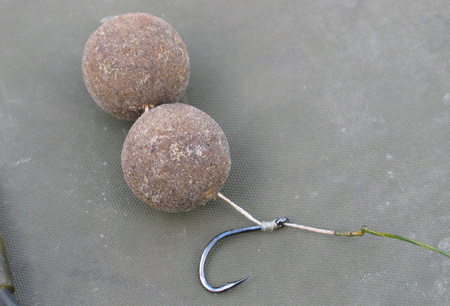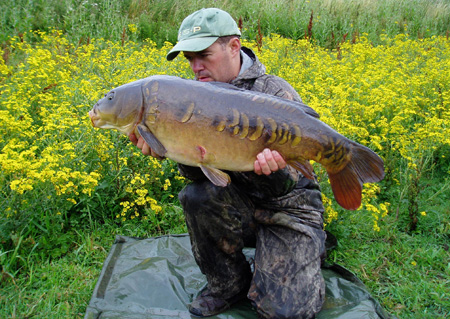In the second part of this series I looked at pre-baiting to draw fish into a swim over a period of two weeks or so. Now in a perfect world, after this amount of baiting, we would all fill our boots on the first night. However, in the real world, this is not always the case – although it certainly can be at times; more likely is that it will take a few more weeks of baiting to get enough fish into the swim to make them catchable. Once fishing has commenced I never stop baiting the river, usually putting in a bucket every other day for as long as my campaign lasts. On a day when I am angling though I will not put any particle in until I am ready to leave as I don’t want the bream hordes to descend.
So to the actual fishing itself.
What I cannot overstate here is just how hard your average river carp will pull. Most of these fish have never seen a hook before so they react in the way that any wild animal does when facing danger: they look to put as much distance between the danger and themselves in as short a period of time as possible. From a fishing point of view this results in some horrendously fast and powerful runs. Therefore you need tackle that is strong and reliable and, just as importantly, tackle that is designed for fighting fish, not for throwing baits to the horizon as that is a technique rarely needed when river carping.
Now tackle will always be a personal choice but I would strongly suggest that the modern fashion for 12ft 3.5lb test curve rods has no place on the rivers. What you want is a rod with a parabolic action, meaning a rod that bends from the tip to the butt so that you can stop these powerful fish on that first run. The last thing that you need on most rivers where marginal growth tends to be high is a carp on a long line and this means stopping the fish as soon as possible.
I learnt my lesson the hard way by losing a very big fish on the River Cam one summer morning by allowing it to take too much line from me resulting in the fish diving into some marginal lilies that I just couldn’t extract it from. My mate actually had the fish’s tail on the spreader block at one point but, stupidly, I was using a triangular net at the time and he couldn’t lift as the cord was snagged under the lilies; the loss of that particular fish will always haunt me but we learn from our mistakes, or at least we should!
 I now use a large, round net that was made for me as a prototype when I was at Fox, which will slash through any marginal growth with ease. Although this model sadly never went into production tough, round nets are definitely the way to go for serious river work.
I now use a large, round net that was made for me as a prototype when I was at Fox, which will slash through any marginal growth with ease. Although this model sadly never went into production tough, round nets are definitely the way to go for serious river work.
Before I leave the subject of rods I ought to state exactly what I use: mine are 12ft 2.75lb test Fox Euro Warriors which have the fabulous playing action that the Warrior range is famed for. These are coupled with Shimano or Fox 10000 reels, loaded with 15lb Nash camo line. At the business end is a Nash diffusion camo leader fished helicopter style with a 6in hooklink of coated braid of some description. The one thing that is slightly different from my ‘normal ‘carp set up is that I have the boilie, or boilies, mounted on a long hair. This makes it all the more difficult for bream to get the hook into their mouth, even if they are playing around with the hookbait. I cannot say it is 100% foolproof as you still get the odd bream suicidal enough to get itself hooked but when I come up with a 100% successful method I shall be selling it to one of the carp companies for a small fortune!
One other decision you need to take is whether to rake your swim or not. It’s true that feeding activity over your pre-bait should ensure a fairly clear area but with eutrophication of most of our rivers these days sometimes the weed is just too much for the fish to clear and in this instance you may need to get out the rake; I would advise caution though. It may be nice to have an area the size of a tennis court to fish over but I doubt the carp see it in quite the same light. Personally I try to keep the area just large enough to get three baits on and it’s fine if the fish themselves then make it bigger and I encourage them to do so by spreading out the pre-bait a bit.
On one successful swim on the Cam an area that started the size of a table top ended up the size of cricket strip as the carp and bream rummaged to find every last seed. But as I have said don’t rely upon this and always have a lead around before you start fishing to see how the area is progressing, this will also give you some idea as to how your pre-bait is working.
On the night that I actually fish the particles are left in the bucket. The only particle I may use is hemp, now some other specimen anglers reckon bream don’t like hemp, I’m not quite so certain but it isn’t at the top of their list like halibut pellets, so I’m prepared to put a bit in the swim. Over that I fish a PVA bag of boilies, both whole and broken, up and a few handfuls of boilies spread around the swim so the carp have to move around a bit to find each bait.

Bear in mind too the effect the current will have on your bait as boilies and, in particular, particles, can easily wash quite a distance away from where you actually want them if you are not careful. A bit of trial and error is needed to get your bait in the right place and you have to adapt from river to river, session to session and indeed during the course of a session if you are on a river which is subject to variable flow patterns.
 The final important piece of the jigsaw is to make really certain that your line control is spot on as, in my experience, there is nothing river carp hate more than lines cutting through the water. Where I can I prefer to use a slack line as, in my opinion, this tends to sit better on the bottom compared to using a back lead, nor is there anything to get hung up or snagged, however there are occasions when back leads are a better choice so I always make sure that there are some in my bag.
The final important piece of the jigsaw is to make really certain that your line control is spot on as, in my experience, there is nothing river carp hate more than lines cutting through the water. Where I can I prefer to use a slack line as, in my opinion, this tends to sit better on the bottom compared to using a back lead, nor is there anything to get hung up or snagged, however there are occasions when back leads are a better choice so I always make sure that there are some in my bag.
Really that’s it. As I have mentioned a few times before river carp are not that hard to catch, but to locate they can be really hard work and you will need to put in a bit of legwork. Add to that the fact that very few rivers are maintained and you may need to fight your way through shoulder high plants just to get to the river, but I will leave you with this picture to sum up what it was about carp fishing on rivers and drains that does it for me.
It was the morning after I had caught my biggest ever carp a 43lb 14oz drain monster; the sun was slowly rising over the Fen and the steam was slowly rising off me and my mate Richard from where we had been weighing and photographing the fish the evening before in a thunderstorm. The air was already humid and the cup of tea, the first of the day vied with the first cigarette of the day as being the most welcome, but despite the great fishing, the great fish and the idyllic setting I could look both ways for over a mile and not only did I not see another carper, but I didn’t see any anglers of any persuasion.
That’ll do for me!













